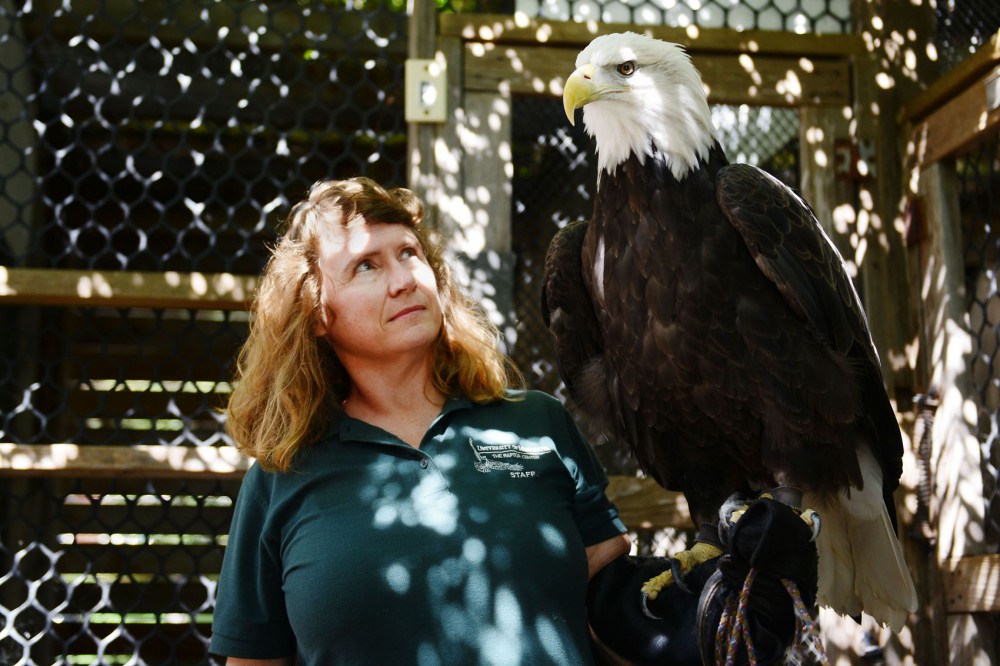The University of Minnesota’s Raptor Center is digging its talons into middle school science classrooms by opening a virtual window for adolescent students into the center’s work rehabilitating sick or injured birds.
The center, located on the St. Paul campus, is developing a new online curriculum aimed at instilling seventh- and eighth-graders with a passion for science, technology, engineering and mathematics.
“We want to create a more sustainable world,” said Julia Ponder, the center’s executive director, “and we do that by teaching students about what’s happening out there.”
In July, the center received a $186,000 grant from the Minnesota Environment and Natural Resources Trust Fund to develop and pilot the program, called the Raptor Lab, said Mike Billington, an interpretive naturalist at the Raptor Center.
Forgoing the usual textbook-and-lesson approach, middle school students will instead learn scientific investigation skills by observing raptor rehabilitation in real time via webcasts, videos and photos, Billington said.
“Students are watching videos of a bald eagle snatching a fish out of water,” he said, “or [ospreys] diving in headfirst with their feet completely extended over their head when they are hitting the water — and most people don’t even know that happens.”
With its recent funding, the Raptor Center will develop the site as a tool for junior high teachers across Minnesota — though how many schools will participate and whether there will be a fee to use the program have yet to be decided, Ponder said.
As part of “adventure learning,” classes will be able to virtually peek into the Raptor Center and keep up with its progress, said Aaron Doering, associate professor and co-director of the Learning Technologies Media Lab, which is helping create the curriculum’s website.
“[It bridges] that distance between the classroom and the Raptor Center and [does] it in a way that’s experiential,” Billington said.
Students will hear directly from veterinarians caring for birds and will play the role of researchers by analyzing blood data and radio graphs provided by the center in order to learn about the diagnostic process, he said.
Another component of the lab pushes students outdoors to do their own investigative research on any topic of interest, Ponder said.
Developers are striving to design the interactive website in a way that will keep young students
interested and engaged, said Jeni Henrickson, media development specialist at LT Media Lab and a learning technologies doctoral student.
When the Raptor Center released a bald eagle tagged with a GPS transmitter in 2010, researchers first had the idea of sharing the experience of veterinarians and field biologists with adolescents, Billington said.
“That was the first iteration was this idea of, ‘How neat would it be for students to learn from the clinic how this bird was rehabilitated?’” he said. “What can this one bird teach us about the population of bald eagles as a whole?”
The Raptor Lab, set to be complete in 2016, will also help introduce students to potential careers in science, Ponder said.
“We want to get students engaged in science and specifically veterinarian medicine,” Ponder said. “We all know that there’s challenges in the science education as far as students following those [career] paths.”
The upcoming course is rooted in the success of a pilot program developed by the center and implemented in metro area schools in recent years, Billington said.
For that ongoing program, students crunch raw data on the number of raptors at the center and interpret them for trends, said Jamie Madson, the STEM integration specialist for Rockford Middle School — Center for Environmental Studies. He said Billington also brings birds to schools and presents about raptor topics.
“I tell the kids, ‘You have no idea how lucky you are,’” Madson said. “You just spent an hour sitting 3 feet from a bald eagle or turkey vulture or whatever it happens to be. People don’t get [that] opportunity.”


